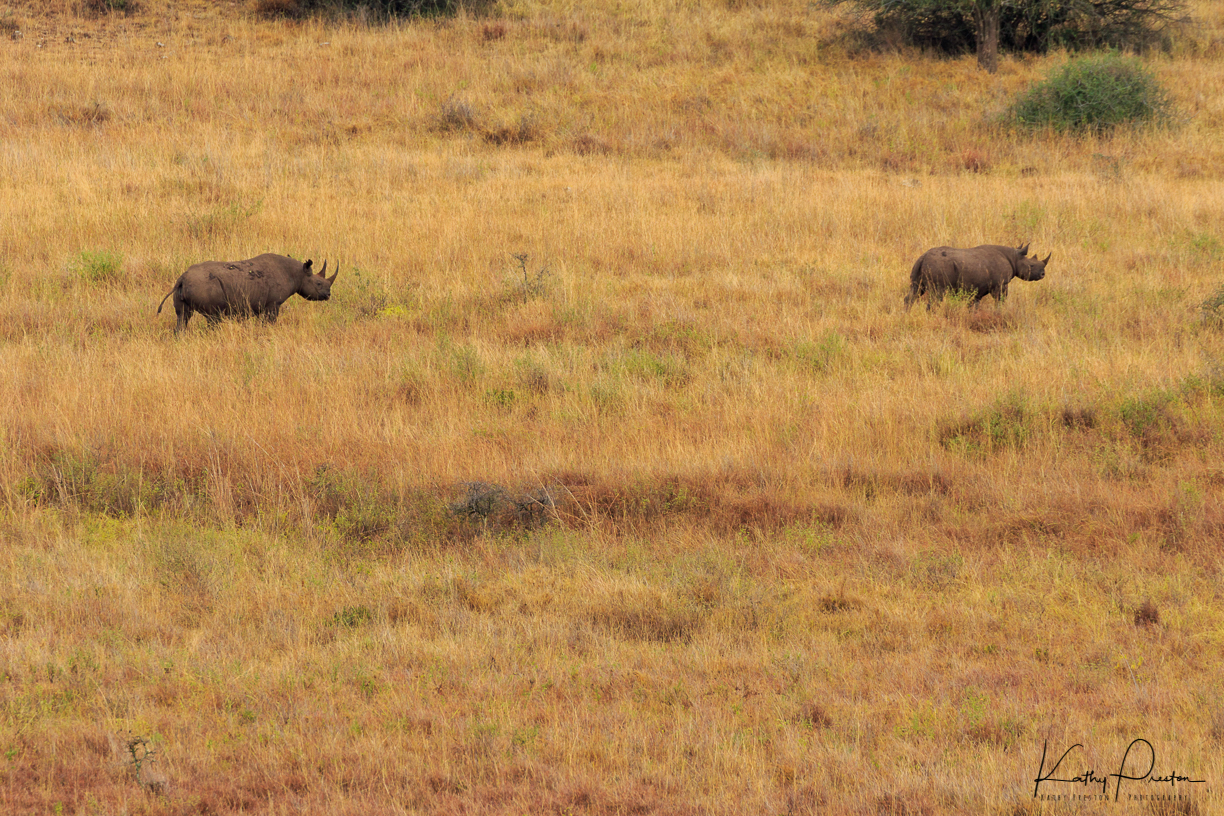- The Amazing Ololo Safari Lodge
- Nairobi National Park – a treasure on the edge of the city
- Sheldrick Nursery & the Giraffe Centre
- A first glimpse of the amazing Masai Mara
- A very full day in the Mara
- A day in (and above) the Mara Triangle
- Helicopter Day
- Big cats and the Masai village of Andasikr
- Saying khwaheri to the Mara and habari to Samburu
- A very special day in Samburu
- A photoshoot with Samburu warriors
The Nairobi National Park is 117 square km and was the first National Park in Kenya, established in 1946. Although small, it is teeming with wildlife and was the biggest surprise of my trip! The park is home to 4 of the “big 5” – lions, leopards, rhinos (both white & black) & cape buffalos (there are no wild elephants here).
Although the southern white rhino is not indigenous to this part of Africa there are several in the Park. Larger than it’s black “cousin”, the white rhino is a grazer, with it’s large head and long neck adapted for that type of eating. It has one short and one long horn; with the females having a longer, spikier front horn than the males.

In the next photo you can see the female (left) compared to the male (right). That rock like object in front of the male is actually her baby who was happily laying down while mom grazed.

The Nairobi National Park is a sanctuary to wildlife and the indigenous black rhino is no exception. Several of these rhino have been relocated to other parts of Kenya, helping to re-establish populations throughout the country.
Other than the size and the difference in the horns, black rhino are browsers (they eat leaves, stems & bark from plants) so they have a much shorter neck. Their back is less flat than the white rhino, looking almost like a saddle.

They’re also much faster and more aggressive than the white ones, who barely took any notice of us.

These are black rhino in the next picture – you can see how the 2 horns of the one in the back are very similar in length but still shorter than the white rhino’s longest horn.

It really is surreal seeing these animals with the Nairobi skyline as a backdrop. This is a Masai Giraffe, one of the 9 sub-species of giraffe. They are easily identified by their leaf-like markings.


There were at least 3 relatively young baby giraffes in the Park – good news for this vulnerable species.



The horns of the female (and immature male) giraffes have black tufts of hair on them while the males are bare, worn off while fighting other males to establish dominance.

This is a male – you can see how his horns have a very different look to them.


There are also large populations of Common Zebra in the park, always eating it seems.

Again, more babies. A good sign!

Baby zebra are on their feet within minutes of birth and walking within hours; it’s a necessity for survival. This fluffy one didn’t look to be very old at all.

It never ceases to amaze me how well camouflaged both the predators and prey are.

These lovely lions were relaxing by a water hole, trying to rest up after their busy night of hunting and eating. They were all very full! Judging by the pink noses and spotty fur, they’re still fairly young, probably only a few years old.



This gent was sitting in the grass, surveying all that was around him from his “hiding” spot. This was taken with a zoom lens and then cropped a little, trust me when I say I have no idea how our guide (who was also driving) managed to spot him off in the distance.

The African Unicorn – a one horned impala. It’s actually a fairly common sight, they often loose them in battle with other males. And they are horns, not antlers, so they don’t grow back.

More babies – this time baby black backed jackals, peeking out of the den to see where mom is. So cute…


The park is home to many birds as well. This is a secretary bird. Not one of the prettiest, but probably one of the funniest.

An then there’s the ostrich – the largest flightless bird. The female ostrich is very plain, mostly brown and white.

While the male has mostly black feathers and a neck and legs that turn bright pink during mating season (to attract the females of course!)

And with a face only a mother could love, a baby cape buffalo.


They’re always telling you the “collectives” in Africa – a tower of giraffes (or a journey if they’re running), a dazzle of zebra etc. I don’t know what the collective is for the rock hyrax, but I look at this and think it must be a “pile”. Too cute.

So there you have it – a few of my favourites from the Nairobi National Park. I also visited the Sheldrick Elephant Orphanage and the Giraffe Centre during my time in Nairobi- that will be my next post so stay tuned!



